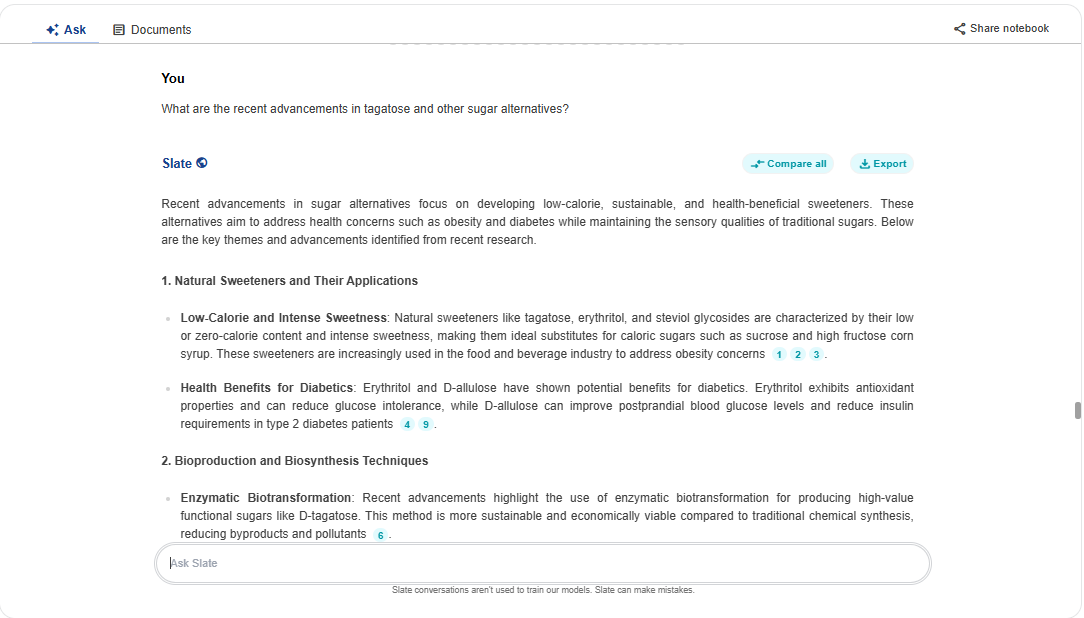Did you know that Tagatose has up to 60% lower calories while being just as sweet as regular sugar? Tagatose is an up-and-coming alternative sweetener that could replace cane sugar from foods. It’s a rare form of sugar derived from natural sources like milk. The global tagatose market is expected to grow to around $250.4 million by 2033.
The rising health consciousness among consumers is driving this growth. Tagatose has a low glycaemic index of 3 and a calorific value of only 1.5 kcal/g, making it ideal for diet foods.
Region-wise, the Asia Pacific is expected to present lucrative growth opportunities for the tagatose market. East and South Asian regions, in particular, are expected to experience high growth rates due to per capita food expenditure and growing urbanization.
For a complete overview of the sugar reduction trends, please fill out the form below to get our exclusive report:
Get the Report in your Inbox
Fill the form to get access to the report
What is Tagatose?
Tagatose is a naturally occurring simple sugar or monosaccharide. It is classified as a ketohexose, which means it has six carbon atoms and a ketone functional group. Tagatose is structurally similar to fructose, another natural sugar in fruits and honey.
What sets tagatose apart is its unique properties, particularly its low caloric content and ability to taste sweet without significantly affecting blood sugar levels. Tagatose is approximately 90% as sweet as sucrose (table sugar) but has only about 38% of the calories, making it a popular low-calorie sweetener.
Tagatose can be found in a few naturally occurring and commercially produced sources.
Can tagatose replace cane sugar or sucrose?
Sugar or sucrose, typically extracted from sugar cane or sugar beet, comprises equal parts glucose and fructose. But Tagatose is a naturally occurring monosaccharide formed from lactose during heating processes.
D-tagatose has approximately 92% of sucrose’s sweetness but contains just 38% of calories. It is tooth-friendly and has minimal effects on blood glucose levels.
Therefore, tagatose can easily be a replacement sweetener for regular cane sugar or sucrose in similar baking and cooking processes.
Commercialization of tagatose sweetener

Biospherics Incorporated developed and filed a patent, US5356879A, for D-Tagatose in 1992, which they licensed to MD Foods in 1997.
MD Foods later merged with a Danish-Swedish multinational cooperative, Arla Foods, in 2001. The following year, Arla Foods announced that tagatose secured FDA GRAS (Generally Recognized As Safe) status, making it ready for sale in the US.
Diet Pepsi was the first commercial product containing tagatose, after which the European Union approved tagatose as a new food ingredient in 2005.
Despite its initial popularity, tagatose production declined in 2006 due to its expensive manufacturing process. Eventually, a subsidiary of Damhert named Nutrilab bought up Arla’s remaining Tagatose supply and made its own products.
In 2007, they launched their branded sweetener, Tagatesse, marketed as a sugar alternative. When Damhert began D-tagatose production in 2007, they modified the production process. However, foods with this sweetener remained for those with expensive tastes.
Interestingly, in January 2023, a startup named Bonumose LLC announced a breakthrough in manufacturing this sweetener. Instead of costly milk-based raw materials, Bonumose uses affordable, widely available plant-based materials. Its processing technique is relatively low-cost enzymatic and yields remarkably high outputs. More details are presented further down this report.

Tagatose vs Allulose
Both tagatose and allulose are similar to sugar’s functionality in areas such as browning for baked foods and freeze-point depression for ice cream. However, the most significant difference between the two is their sweetness.
Allulose is only 70% sweeter than sucrose, whereas tagatose is over 90%, as highlighted earlier. But it has only 0.4 calories/gram, considerably lower than tagatose.
Learn all about allulose to see if it can be a better solution for your sugar reduction needs.
Latest tagatose patent filing trends
Here are the latest patent filing trends data for tagatose compared to allulose.

Throughout these years, tagatose hasn’t been as heavily patented as the latter. It’s clear that allulose caught on among many innovators in early 2013, whereas tagatose saw a more gradual rise with a jump in the number of patents for both sweeteners in 2019 and 2022.
The steep decline in 2023 is simply because most patent applications aren’t publicly available yet.
Industry leaders see Tagatose as a promising alternative sweetener.

Several prominent industry leaders, like Hershey’s, ASR Group, and Symrise Flavors, have expressed interest in Tagatose.
In February 2021, ASR Group, the world’s largest cane sugar refiner and marketer, made a strategic investment in Bonumose. As of July 2023, Symrise Flavors has signed a minority investment agreement with Bonumose. Hershey’s, too, invested in Bonumose, enabling it to set up a $27.7 million, 36,000-square-foot manufacturing plant.
Hershey’s investment in Bonumose’s Tagatose solutions hints at a potential range of commercial products featuring its health benefits in the future.
Breakthrough innovations in tagatose
Bonumose’s Cost-Effective Production: As stated earlier, Bonumose has developed a new tagatose manufacturing process. They’re using cornstarch instead of lactose from milk, which can significantly lower production costs by 80% to around $3/kg.
New Spray-Drying Formulation: Researchers from the University of Kentucky Research Foundation have developed a cost-effective spray-drying technique for D-Tagatose. This method can reduce some of the costs associated with its large-scale production.
Advantages of using tagatose sweetener in foods
Low Caloric Content: Tagatose 1.5 calories per gram is significantly lower than the four calories per gram provided by regular cane sugar. Furthermore, studies indicate that it can help regulate blood sugar levels by blunting the rise in glucose levels by blocking the absorption of carbs/sugar from other foods.
Sweetness: It is nearly indistinguishably sweet as table sugar, making it an excellent substitute for regular sucrose.
Low Glycemic Index: Tagatose has a low glycemic index, meaning it has minimal effects on blood glucose and insulin levels.
Tooth-Friendly: Unlike most common sugars, tagatose does not promote cavities.
Prebiotic Effects: Tagatose has prebiotic effects, feeding healthy gut bacteria with dietary fiber.
Baking Properties: The chemical properties of tagatose make it similar to baking with sugar. It browns slightly faster than sugar, offering familiar, rich caramel and malt flavors.
Drawbacks and challenges of using tagatose
Added Sugars Labeling: The U.S. Food and Drug Administration (FDA) has ruled that when used as a food ingredient, tagatose must be disclosed on product labels as “Added Sugars.”
This ruling was made even though research has found that tagatose does not increase the risk for chronic disease and instead has been shown to have positive health effects. The FDA stated that tagatose has too many calories to be exempted from the label designation.
Digestive Issues: Tagatose is only partially absorbed by the gastrointestinal tract, which can lead to digestive issues such as nausea, diarrhea, and flatulence in some people.
Stability Issues: Tagatose powder is susceptible to sticking, deliquescence, discoloration, and degradation, especially at higher relative humidities and temperatures. In solution to this, citrate and phosphate buffers can catalyze tagatose degradation, especially at higher pH levels.
Conclusion
Tagatose is an exciting alternative to high-potency sweeteners and sugar alcohols such as sucrose. Its familiar taste and many health benefits make it an ideal choice for foods with high-sweetness ingredients.
While the FDA food labeling mandate is still a rather unfair hurdle, the benefits are hefty enough to get the attention of industry juggernauts looking into sugar reduction solutions for 2024.
To get more information about research in tagatose and other sugar alternatives, try our AI-based research tool SLATE. Find answers to all your research-related questions in one place!

Authored By – Gaurav Sahni, Intelligence Team
Edited By – Hemanth Shenoy, Marketing











